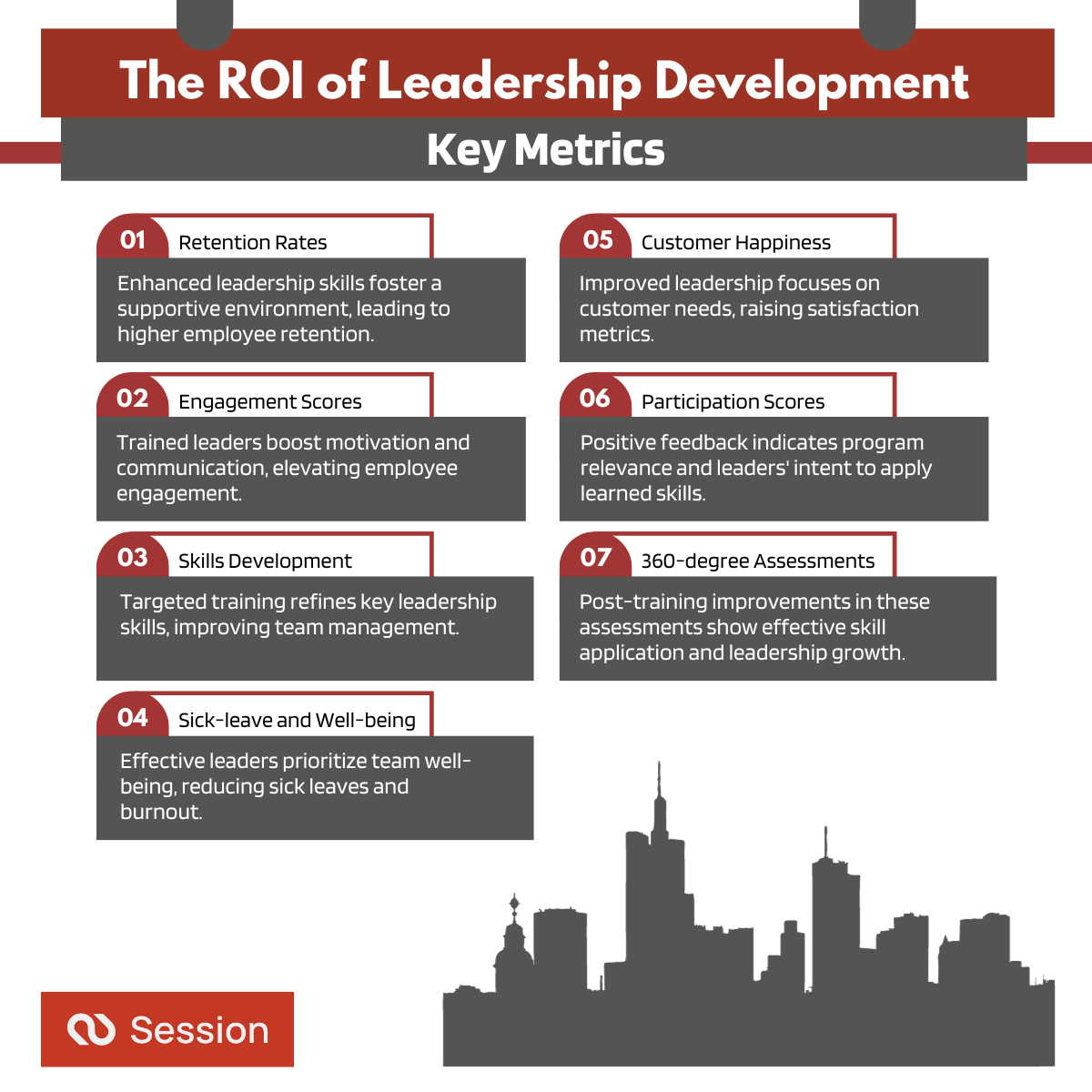Investments in leadership training and leadership skills training are an important driver of success for any business. Great leaders make for better and happier employees, which not only increases engagement but also ensures higher retention and better performance.
A study from 2019 found that running first-time managers through a leadership development program offered a 29% ROI in the first 3 months, and a 415% annualized ROI. This means that the business made $4.15 for every $1 spent on training.

Need we say more? Yes we do. Tighter economic conditions have forced many companies to cut back on their spending budgets. Learning and development has taken a hit, and leaders are looking for ways to measure and prove the ROI of their expenditure. Consequently, HR and Learning and Development (L&D) teams must have a plan in place to measure impact of their programs to justify bankrolling when it comes to the need for leadership development programs in their organizations.
But how exactly can this be achieved? In this guide, we’ll run through effective solutions for measuring the ROI for leadership development programs.
Define Aim of and Success Criterias for the Program
To successfully be able to measure the ROI on your leadership development program, you first need to define the aim of and success criterias for the program. In order to do this you must ask yourself (and answer) three concrete questions:
- What kind of problems are we facing, that the leadership development program should address and do something about? This could for instance be the fact that the company is experiencing too many customer complaints and low engagement scores internally.
- What kind of behavior do we believe will lead to improvement within these areas? This could for instance be leaders being better able to conduct 1:1 conversations and build a culture of performance and continuous feedback.
- What would we like to see happen once the program has run its course? What would be concrete and tangible signs that the program has been a success and worth the money invested? This could for instance be great retention rates, a common language and way of behaving by the leaders in the company - in accordance with the company values - and high customer and employee happiness and engagement. We will walk through some of the most common metrics to prove the ROI below.
Additionally, the company's overall strategic direction must be considered when deciding what kind of concrete behavior the leadership program should train. Management often spends money and time on generalized leadership training, which doesn't always correlate to what you want to accomplish as a company. So make sure to have clear success criteria and objectives for the program, which you can easily evaluate after the program is finished and which can be directly linked to the overall success of your company.
Metrics to Prove the ROI
According to an article by SHRM, only 18% of businesses are gathering relevant business impact metrics, which may be why some experts have questioned the worth of these programs!
In the following we are running through some examples of metrics to measure, which can prove the business case of your investment and make the ROI of your leadership development program visible and clear:
- Retention rates. Do the employees, who participated in the leadership development program, stay longer than the average employee? Does the overall retention rate in the company rise in the tail of the implementation of the program?
- Engagement scores. Engagement surveys are great measures to prove that the investment in leadership training has been worthwhile. Many studies show how engagement is linked to performance, therefore, this is a measure you must not miss.
- Skills development. Measuring progress within concrete leadership skills trained as part of the leadership development program is a great way to directly prove the benefit and ROI of the training. Does leadership become better at communicating, giving feedback, and leading change - according to employees and relevant other stakeholders?
- Sick-leave and overall well-being. Looking at the percentages of employees on sick-leave as well as their overall wellbeing before and after the leadership development program has run can be a very tangible and concrete way of proving that the training program has paid off (in the case where sick-leave falls and reported wellbeing and happiness rise).
- Customer happiness. What was the nps score prior to the program running? What is after? What about the % of customer complaints? Or the qualitative feedback you get from customers, including comments on for instance trustpilot?
- Participation satisfaction scores. How high do the participants of the program evaluate the program? How satisfied are they with overall quality, the trainers, the content, venue - and how much do they themselves feel they have gotten out of the time spent on the program? Was it, in their opinion, worth the investment?
- 360-degree Assessments, showing how high people around the participant score the actual change in behavior from the leader and how well transfer of learning from the training to day-to-day activities has been implemented, in the opinion of the participants direct reports, manager, customers, and other stakeholders.
The above are powerful data to prove the ROI of your investment into the leadership program, giving you the opportunity to call for another roll-out of the program, another iteration or another investment in similar initiatives to strengthen leadership within your organization.
Conclusion
In the end, leadership development programs should not just serve the individual participant, but the organization as a whole. Measuring the ROI on your programs ensures that organizational goals are being attained, and that employee development is moving in the right direction. As Peter Drucker once famously said ‘’You can't improve what you don't measure”, and this couldn’t be more true when it comes to leadership development! Investing in leadership development programs is a no-brainer for L&D and HR teams, but to convince management of its effectiveness, knowing how to measure ROI is a necessity.
At Session, we know how important it is to track ROI for our coaching journeys. We provide regular check-ins and feedback surveys to ensure that programs and journeys stay on track. Additionally, when 8+ employees undertake coaching, we make quarterly trend reports highlighting issues, recommendations, and tips for HR to stay up-to-date. Curious to learn more about advancing leadership development with Session? Reach out to our team to learn more.












